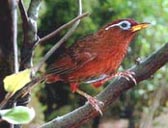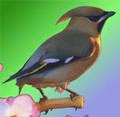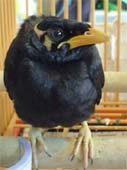There are 1,175 species of birds in china, one of the nations boasting the richest bird species in the world. Among so many species of birds, there are 100 more or less available for cage rearing and appreciation.
China has a long-standing history in breeding birds for display. Parrots have been raised as pet birds since the Zhou Dynasty (11BC-256BC), homing pigeons have been kept since the Han Dynasty (206BC-8AD) and orioles have been kept in cage since the Tang Dynasty (618 -907). In the Song Dynasty (960-1279), except for raising pigeons, keeping caged lavrocks and song thrushes was also prevailing. During the Ming (1368-1644) and Qing (1644-1840) dynasties, in a general way, many well-off families were fond of aviculture which became a recreation in their daily life.
The Chinese ornamental birds can be divided into the following types:
 Chirping Type
Chirping Type
 |
| Chirping Type |
Chinese people give their special attention to the chirping of the birds. Some of avian voices sound excited and impassioned, some sound clear and resounding and flowing, and some sound soft and smooth and even sweet and agreeable, providing people with various artistic enjoyment. The ornamental birds mainly characterized by their chirping include song thrush, lavrock, laverock, siskin, goldfinch, white-headed bulbul, red-eared bulbul, red-mouthed blue magpies, white-throated sandpipers, magpie robins, lovebirds, Luscinia calliopes and ousels, etc. As the story goes, lavrock, the bird endowed with the most brilliant singing talent in the bird population, can sing "13 series of melodious tones", which is quite like a chorus with complete musical instruments.
 Appearance Type
Appearance Type
 |
| Appearance Type |
The appreciation value of this kind of birds is judged according to the beauty of their feathers. The species endowed with relatively higher ornamental value include red-mouthed blue magpies, orioles, shaft-tailed whydahs, cross-beaked sparrows, chaffinchs, waxwings, red-eared bulbuls, white-throat sandpipers, gray-crowned redstarts, lovebirds, Japanese white-eyes, hoopoes, etc. In addition to appearance, whether the posture is graceful when flying in the sky is also an important criterion to judge its ornamental value; the most famous birds of this type include lavrocks, laverocks and Japanese white-eyes, etc.
 Fighting Type
Fighting Type
The ornamental value of this type lies in their skills in fighting. The birds endowed with such talent include brown-headed elegant sparrows, song thrushes, quails and magpie robins, etc.
 Acrobatic Type
Acrobatic Type
This kind of birds, such as siskin, gros-bec, goldfinch, Crossbills, bramblings, linnet and White-backed Munias, can perform acrobatics through training.
 |
| Acrobatic Type |
Pigeons are worth mentioning in the acrobatic type. In the Han dynasty (206BC-8AD), Zhang Qian, a famous diplomat at that time, once used homing pigeons to deliver messages when he was sent on a diplomatic mission to Turkestan (or the West Region). During the Tang (618-907) and Song (960-1279) dynasties, raising pigeons was rather popular. There are various ornamental pigeons in china: such as "snowflake", which is white all over except for a black-haired head; "black coat", with a black-feathered body but a white-haired head; "black in head and tail, both the head and tail are pure black; pied magpie "with zebra-colored feather; "sector pigeon", the number of whose tail feather are two times that of other pigeons; spectacles pigeon", with outsized eye socket; somersaulting pigeon", specializing in somersaulting.
 Imitation Type
Imitation Type
This type of bird, such as parrots, mynahs and grackles, through training, can imitate the human language and the sound of other birds and beasts, as well as diversified mechanical sound including the warning horn of automobiles and trains.
